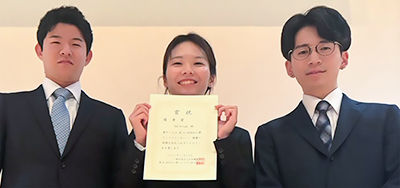Newsletter 2025.2 Index
Theme : "The Conference of Fluid Engineering Division (Part 1)"
|
The 21st Dream contest of the flow Moment of healing
 |
Nihon University (Team: NU S-Lab) |
Abstract
We participated in “21th The Dream of Flow Contest” with the theme of “contributing to the achievement of the SDGs via flow”, and we were selected for the Excellence Award.
In Japan, which is prone to natural disasters, rivers overflow due to downpours, and plastic products used in daily life are swept away along with the trees and sediment. These plastics and wood are broken down into fine particles by long-term floating, and they arrive on the shore. We decided to make a project that contributes to the SDGs from another viewpoint, from “Don't flow into the sea” to “Even if it flows into the sea.
We presented technology for separating these microplastics and wood fragments.
Although the main component of wood, cellulose, has a density of 1.5 g/cm3, which is greater than that of water, the density of lumber is lower because it contains hollow spaces called “vessels” that transport nutrients and water. By filling these vessels with water, it is possible to separate the wood from the plastic by sinking only the wood in the water.
We also considered a device that reduces the density of the liquid by mixing air bubbles into the water and then sinking the plastic.
We named the title of this project “Densitin”. because it manipulates the density to sink the wood and plastic floating on water. (The Japanese word for sink is read as “chin”, ”tin”)
By applying pressure at 1 atm, we were able to quickly absorb water into the wood chips and sink them in the water. The device for sinking plastics needs some more improvement because the air bubbles induced convection flow.
Key words
Key words: density, separation technique, microplastic
Figures
Wood chips sink in the water at 1atm |
Plastic pellets sink? in bubble-infused water |

